Bocas is at the head of a ten mile long lagoon that gradually shallows as
one sails east. Thus, as we left Bocas in a
strong west wind, we felt we
could only safely sail fast for about an hour. The shallowest parts of the
lagoon are less
than 8ft deep, amongst a maze of islets and reefs with only
a narrow, hard to spot, gap to the open sea. So we
lowered the mainsail and
sailed on cautiously, at one point we even rolled away the genoa yet were still
doing two
knots under bare poles, which felt plenty fast enough. In late
afternoon we had cleared the last shallow reef and
headed out to sea towards
Salt Creek, where we anchored for the night, close to shore, having weaved our
way
through yet more coral reefs.
Next morning the wind was stronger still, and we ran downwind under genoa
alone in a very steep confused sea,
presumably caused by the river currents
running out of the Bocas lagoon, to the isolated riverside village of Tobobe.
Tobobe has no road access and is twenty miles by sea to the next village; it
was a real step back in time, the village
looking much as it must have done
when Columbus passed by.

Villagers paddled out in their canoes, a few had fruit and fish to sell,
but most just hung onto the boat, staring.
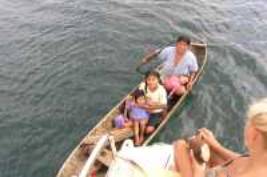
Jetti made them a cake and traded toys for bananas. After 2 days the
village harbourmaster came past in his
dugout canoe, took our details and
asked for 20USD harbour dues. Or maybe he was just a conman – we
didn’t get
a receipt, and we are still not sure, in any event he was very convincing.
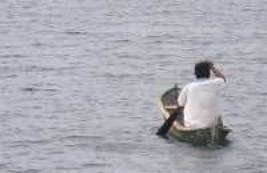
The 130 mile sail to the Rio Chagres, just west of the Panama Canal,
would be our longest sail for the next two
months, so we stayed at Tobobe
until the rain stopped and the wind moderated. We left in another westerly
(they are common during the rainy season) and so, for the first time since
leaving Guatemala six weeks earlier,
we were able to sail downwind in open
water. Sadly, after fifty miles the wind dropped and then veered round
to
the east, so it was back to windward bashing. At midnight I woke Jetti with the
words. “It’s your watch,
and by the way – Happy New Year!” Two years ago New
Year was spent at anchor in Grenada, last year
it was in Nassau, but this
was the first New Year when we’d actually been at sea. Where will we be next
year?
The river Chagres is one of the main Panamanian rivers and had caused
huge problems when building the
Panama Canal until it was eventually dammed,
thus helping to control the water level in Lake Gatun. The
river entrance
beneath the ruins of Fort San Lorenzo is very narrow and in the dawn light it
seemed impassable.
But fortunately a local boat was entering as we arrived,
so we followed it in, through a 60ft wide gap between
two rows of surf and
inside a reef. It reminded me of entering Bigbury on a bad day but at least
there was no
one on surfboards here! Once inside all was quiet and calm, and
we found that the jungle came right down
to the water on either bank. We
motored up river for about three miles and anchored only a boat length from
the shore in 45ft - the shallowest place we found. Blue and yellow macaws
flew overhead, while as dusk fell
howler monkeys began their roaring; that
was a familiar sound, but what was making that other noise?

A couple of canoes had passed us during the day so that night we debated
about turning on the anchor
light – it would warn approaching boats of our
presence, but what would it attract? In the end we compromised
and left a
cabin light on. Next morning on the cruiser’s radio chat session someone
reported seeing a large
snake swimming past his boat. So the discussion
started – could they/ would they climb onto a boat? Maybe
transom steps and
a boarding ladder are not such a good idea after all! It was certainly not what
we wanted
to hear anchored in the middle of the jungle.
We were still trying to get to the San Blas for Christmas(!), so all too
soon we were on again, bashing into a
25 knot NE wind, past the breakwaters
and anchored ships that mark the entrance to the Panama Canal.
As dusk fell
we dropped anchor in Portobello, thirty miles nearer our goal.
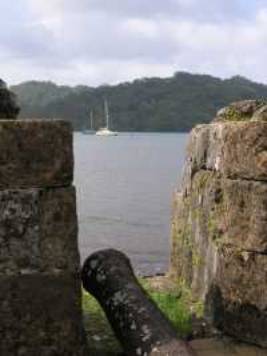
And that’s when the real waiting started. Except in strong westerlies,
Portobello is a really safe anchorage
and has two claims to fame. First, it
is where Sir Francis Drake is buried. Second, it is officially the wettest
town in all of North America. Like Drake, Eclipse’s home port is Plymouth.
There Drake is a hero and spent
part of the wealth he gained on the “Spanish
Main” building houses and making Plymouth’s first good water
supply (his
reservoir is still there). In Panama, as elsewhere in Central America, he’s
considered a villain.
Travelling round the Caribbean I’d seen forts built by
the Spanish to protect their colonial towns from
Drake – in San Juan,
Havana, St Augustine - he certainly got around! And don’t forget he also claimed
San Francisco for England, was the first commander to sail round world and
he played bowls before beating
the Spanish Armada (his bowling green in
Plymouth is still in use today). Yet after all that, he died of yellow fever
aged 54 and is buried in a lead casket off Drake’s Island at the entrance to
Portobello.
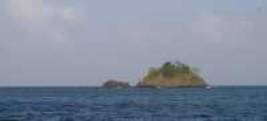
Four hundred years ago Portobello was the main despatch point for all the
gold and silver taken from the South
American mines, and we learnt that in
its heyday silver ingots were left lying in the streets as the warehouses
were completely full of gold. Now it’s run down, while the four forts
guarding the harbour were partly dismantled
to build the Panama Canal.
Fortunately the Customs House was recently rebuilt, but there is still no proper
museum
and nothing to indicate that for two hundred years Portobello was the
most important town in Central America.
Despite that, we liked the town.
There were several small restaurants and four shops, all run by Chinese.

Day after day it rained and the wind blew hard. Officially the rainy
season was now over, but clearly
Portobello deserved its place in the record
books.
One day though, we took a one hour bus ride to a “real” supermarket, the
first we’d seen in over a year of cruising.
On another day we did a double take,
for coming round the headland we saw a square rigged ship. It looked too
big
to be the Golden Hind and as it came closer and anchored, I spotted the
Australian flag flying astern. I had just
finished reading “Blue Latitudes”
and so quickly realised that it was the replica of Cook’s Endeavour. But it made
us realise how vulnerable the bullion ships were as they waited for their
cargo. No wonder they needed four forts
for protection. Next day the locals
called it the “ghost ship”.

Since leaving Bocas we had been looking for somewhere to leave the boat
when we fly home at Easter.
In Portobello we learnt of a new marina,
Panamarina, just a few miles further east. After a week at anchor
I could
wait no longer and in a still strong wind (25-30 knots) and big steep seas
(probably reaching 14 ft)
we sailed round the corner and checked out the
marina.

It is run by a French couple and looked OK, and so we booked Eclipse in
for late March. Eclipse will be
the first English yacht to stay there. Then
it was on a couple more miles to Isla Grande and Puerto Lindo,
reputedly the
safest yacht anchorages on this coast. Twenty five other cruisers certainly
thought so.
More waiting.
Eventually, after eleven days, the wind began to moderate, and we left to
sail in a steadily decreasing wind to
Escribanos. Another narrow entrance
between two reefs took us into a shallow river, only 5ft deep, where
we
spent a quiet and peaceful night. Then finally a short fifteen mile sail next
morning to the very crowded
anchorage at Provenir, the clearing in port for
the San Blas.

At last we’d got there.
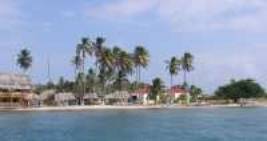
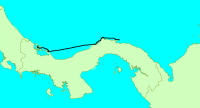
Route Bocas to Porvenir












